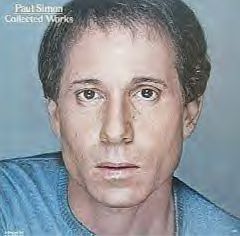" Paul Simon "
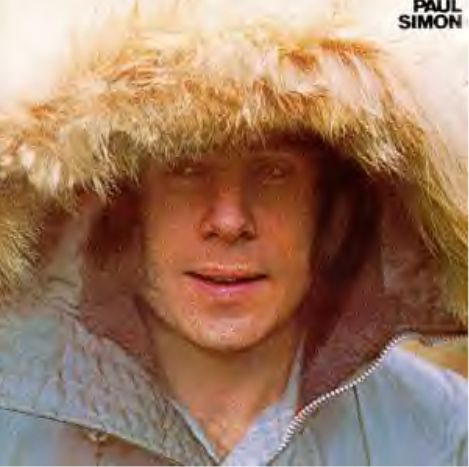
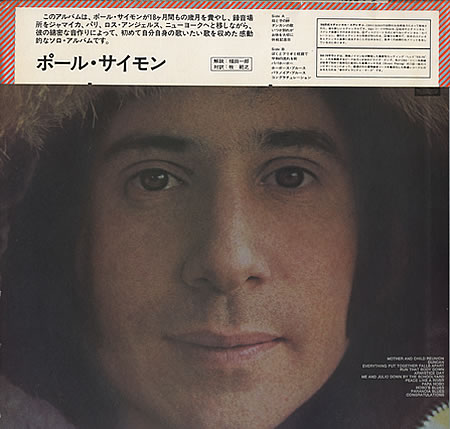
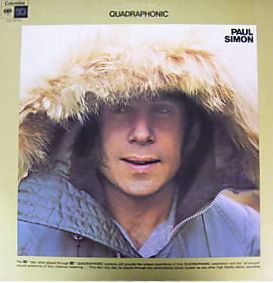
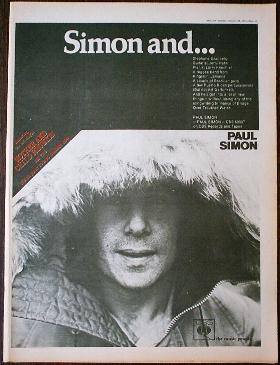
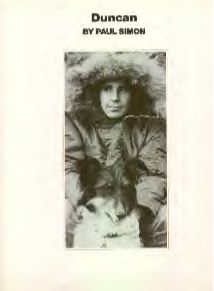
Paul Simon (album)
Studio album by Paul Simon
Released January 14, 1972
Recorded 1971
Genre Folk rock
Length 34:03
Label Columbia Records, Warner Bros. Records
Producer Roy Halee, Paul Simon
Professional reviews
Allmusic link
Robert Christgau (A+) link
Paul Simon chronology
The Paul Simon Song Book
(1965) Paul Simon
(1972) There Goes Rhymin' Simon
(1973)
Paul Simon is a 1972 album by Paul Simon, released about two years after he
split up with longtime musical partner Art Garfunkel. It was originally released
on Columbia Records, but is now on the Warner Bros. label. Musically, it is
a direct follow-up from his work with Simon and Garfunkel. The song writing
quality that is revealed in Simon and Garfunkel songs like "The Only Living
Boy in New York" and "Song for the Asking" is, on Paul Simon,
extended and combined with a new appreciation for the album as a complete and
single work of art.
The album includes many autobiographical elements. Several songs on the
album make reference directly or indirectly to his rocky marriage to Peggy (nee
Harper), which ended in divorce in 1975. Troubles with the marriage figure prominently
on songs such as "Run that Body Down" (in which both "Paul"
and "Peg" are mentioned by name) and "Congratulations".
Other themes include drugs and adolescence, especially in urban areas.
The albums of Simon and Garfunkel and the later works of Paul Simon share
similarities with this album. Specifically, the songs "Mother and Child
Reunion" and "Me and Julio Down By the Schoolyard", and some
of the percussion by Airto Moreira and Los Incas, prefigure the fascination
Simon had with world music, particularly on Graceland.
The album reached #4 in the U.S. and #1 in the United
Kingdom and Japan.
Track listing
All songs composed by Paul Simon except where noted.
"Mother and Child Reunion" – 3:05
This song is considered to be one of the first attempts at reggae music by a
white musician (although many scholars point to the Beatles' "Ob-La-Di,
Ob-La-Da" as an earlier example of reggae by a white artist). The name
has its origin in a chicken-and-egg dish which Paul Simon saw on a menu at the
Chinese restaurant Say Eng Look Restaurant in New York City's Chinatown.
"Duncan" – 4:39
This song recalls Simon and Garfunkel's "El Condor Pasa (If I Could)"
due to its wind instruments and emotional feel.
"Everything Put Together Falls Apart" – 1:59
"Run that Body Down" – 3:52
"Armistice Day" – 3:55
"Me and Julio Down by the Schoolyard" – 2:42
"Peace Like a River" – 3:20
"Papa Hobo" – 2:34
"Hobo's Blues" (Simon, Stéphane Grappelli) – 1:21
"Paranoia Blues" – 2:54
"Congratulations" – 3:42
"Me and Julio Down by the Schoolyard (Demo - San Francisco 2/71) [2004
reissue bonus track]"
"Duncan (Demo - San Francisco 2/71) [2004 reissue bonus track]"
"Paranoia Blues (Unreleased Version) [2004 reissue bonus track]"
Personnel
Musicians
Paul Simon: acoustic guitar, vocals, percussion, producer, arranger (all tracks)
Hal Blaine: drums (4, 10, 11)
Huks Brown: lead guitar (1)
Ron Carter: bass (4)
Russel George: bass (6)
Stephane Grappelli: violin (9)
Winston Grennan: drums (1)
Stefan Grossman: bottleneck guitar (10)
Jerry Hahn: electric guitar (4, 5)
Neville Hinds: organ (1)
Jackie Jackson: bass (1)
Larry Knechtel: acoustic and electric pianos, harmonium, organ (1, 3, 8, 11)
Denzil Laing: percussion (1)
Fred Lipsius: horns (5)
Los Incas: flute, charango, percussion (2)
Mike Manieri: vibes (4)
Charlie McCoy: bass harmonica (8)
Victor Montanez: drums (7)
Airto Moreira: percussion (5, 6)
Joe Osborn: bass (7, 11)
John Schroer: horns (5, 10)
David Spinozza: acoustic guitar (4, 6)
Steven Turre: horns (10)
Wallace Wilson: rhythm guitar (1)
Cissy Houston, Von Eva Sims, Renelle Stafford and Deirdre Tuck: backing vocals
(1)
Production and Engineering
Roy Halee: co-producer, engineer
Leslie Kong: contractor (1)
Bernard Estrady: additional engineer (2)
Phil Ramone: engineer (6)
US LP - PAUL SIMON
Columbia LP KC 30750 (stereo); QUADLP CQ 30750 (quadraphonic);
Warner Brs CD 25588
Mother And Child Reunion
Recorded in Kingston, Jamaica.
Huks Brown - lead guitar; Wallace Wilson - rhythm guitar;
Neville Hands - organ; Jackie Jackson - bass; Winston Grennan - drums; Denzil
Laing - percussion; Larry Knechtel - piano; Cissy Houston, Renelle Stafford,
Deirdre Tuck & Von Eva Sims - singers.
Duncan
Recorded in Paris, France.
Paul - guitar; Los Incas - charango, flutes & percussion.
Everything Put Together Falls Apart
Paul - guitar; Larry Knechtel - harmonium & electric
piano.
Run That Body Down
Paul & David Spinoza - guitars; Mike Manieri - vibes;
Jerry Hahn - electric guitar; Ron Carter - bass; Hal Blaine - drums.
Armistice Day
Paul - guitar; Jerry Hahn - electric guitar; Airto Moreira
- percussion; Fred Lipsius & John Schroer - horns.
Me And Julio Down By The Schoolyard
Paul & David Spinoza - guitars; Airto Moreira - percussion;
Russel George - bass.
Peace Like A River
Paul - guitar; Victor Montanez - drums; Joe Osborn
- bass.
Papa Hobo
Paul - guitar; Larry Knechtel - harmonium; Charlie McCoy
- bass harmonica.
Hobo's Blues (Simon & Grappelli)
Recorded in Paris, France.
Stephane Grappelli - violin; Paul - guitar.
Paranoia Blues
Recorded in Los Angeles, CA.
Stefan Grossman - bottleneck guitar; Hal Blaine - drums;
Paul - percussion; John Schroer & Steven Turre - horns.
Congratulations
Paul - guitar; Larry Knechtel - piano & organ; Joe Osborn
- bass; Hal Blaine - drums.
Album recorded in Jamaica, Paris, NY, LA & San Francisco.
Produced by Paul & Roy Halee.

Format: LP RECORD
Japanese vinyl releases are premium quality pressings, much sought after by
audiophiles and collectors alike. In the 1960s Toshiba pioneered top quality
red vinyl pressings using their trademark ‘Ever-Clean’ process this
utilised a special ingredient intended to prevent the build-up of static electricity
on the vinyl. Japanese pressings are synonymous with quality - the vinyl shines
like no other vinyl - everything about their releases feels special. When US
audiophile label Mobile Fidelity Sound Lab first released their series of high
quality pressings the records were manufactured in Japan. The sonic quality
of Japanese pressings is considered to be among the best in the world and, in
addition, they are beautifully presented, their covers usually printed on better
quality heavy stock paper and often including a bonus lyric insert with dual
language Japanese & English text. Nearly all Japanese LPs were issued with
an ‘obi’ - literally translated this means ‘sash’ and is
derived from the obi (sash) worn around the traditional kimono dress. This delicate
paper strip, usually wrapped around the left side of the album cover, often
contains marketing information and album content details, all printed in Japanese
kanji and ~kana script. Obi designs can be as varied as the LPs they adorn,
and some series of obi designs can be as collectable as the artists’ albums
they decorate. ‘Hankake’ (3/4 length obis) are nearly impossible to
find, and the ‘Rock Age’ series of obis are especially rare and valuable.
Obis make a unique, attractive addition to the overall package and are becoming
increasingly rare, especially on LPs from the 1960s and 70s. Their delicate
and disposable nature meant that very early obis were routinely discarded, so
that now they can often be worth several times more than the record they accompany.
In addition to Japanese pressings of regular albums there are numerous Japanese-only
releases. Labels and artists often issued exclusive records timed to coincide
with their Far East tour, or they re-released back catalogue albums with a re-designed
obi, displaying revised graphics and other consumer information. Regardless
of your musical taste, Japanese records make a stunning addition to any collection.
Audibly and visually they present the collector with a feast of delights. Genuine
mint condition records, complete with inserts and obi, are becoming rarer every
day. Whatever the digital age throws at you there is still a valid opinion that
says vinyl sounds best; with Japanese records you get top quality pressings,
a tactile picture sleeve that looks stunning and you can sing along from the
lyric insert.
Record Label: CBS/Sony
Catalogue No: SOPN-42
Country of Origin: Japan
Released as part of the box set Paul Simon Collected
Works. 